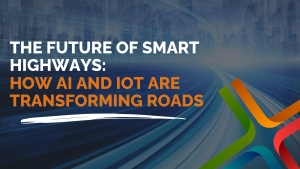The Future of Smart Highways: How AI and IoT Are Transforming Roads
The integration of Artificial Intelligence (AI) and the Internet of Things (IoT) is revolutionising the UK's highway infrastructure, leading to safer, more efficient, and sustainable road networks. These advancements are not only enhancing the driving experience but also contributing to environmental goals and economic efficiency. From predictive traffic management to real-time hazard detection, this blog explores how AI is shaping the future of transportation.
AI-Powered Road Maintenance
Maintaining road infrastructure is a constant challenge, particularly when it comes to identifying and repairing potholes before they become hazardous. Traditional road inspections rely heavily on manual assessments, which can be time-consuming, costly, and sometimes inefficient. However, with the advent of AI-driven solutions, local authorities are finding innovative ways to improve road maintenance, making it more proactive and efficient.
Surrey County Council’s AI-Driven Approach
Surrey County Council has taken a major step forward in modernising road maintenance by integrating artificial intelligence into its operations. The council has equipped highway maintenance vehicles with advanced computer vision cameras that automatically detect and photograph potholes in real-time. These AI-powered cameras continuously scan road surfaces, identifying cracks and defects that may not be visible to the naked eye.
Once a pothole is detected, the system records its precise location and severity, generating detailed reports that allow maintenance teams to prioritise repairs. This automation not only speeds up the repair process but also reduces the need for manual road inspections, thereby improving worker safety and minimising disruption to traffic.
In a similar vein, researchers have developed a self-healing bitumen that repairs cracks as they form, preventing potholes without human intervention. This innovation, created by an international team in collaboration with King's College London and Google Cloud, uses machine learning to model the material's behaviour. The self-healing roads could be in use in the UK within a few years, potentially extending road lifespans by 30%.
Smart Traffic Management with IoT
The IoT is playing a crucial role in transforming traffic management on UK highways. By connecting devices, sensors, vehicles, and central control systems, IoT enables real-time, data-driven approaches to traffic management. For instance, AI-driven image recognition technology can automatically alert traffic management centres to dangerous situations, allowing for quicker emergency responses and reducing the likelihood of secondary accidents.
With AI and IoT sensors monitoring traffic in real time, predictive analytics can forecast congestion patterns before they occur. These insights allow authorities to:
- Redirect traffic – Digital road signs and navigation apps can suggest alternative routes in advance.
- Implement variable speed limits – Adjust speed limits dynamically to prevent stop-and-go traffic.
- Issue early weather warnings – Sensors detect fog, ice, or heavy rain, automatically warning drivers via digital signage.
Manchester’s AI-Powered Traffic Flow Management
Manchester has deployed an AI-based traffic prediction model that analyses data from IoT sensors to forecast congestion. If an area is predicted to experience heavy traffic, the system can redirect vehicles using navigation apps like Waze or Google Maps, reducing bottlenecks.
Digital Roads
The Digital Roads Initiative aligns with the UK's broader goals of enhancing transportation infrastructure, promoting sustainability, and embracing technological advancements to improve public services. By integrating cutting-edge technologies and data-driven strategies, the initiative aims to create a safer, more efficient, and user-friendly road network for the future.
National Highways Digital Roads Initiative
National Highways has launched the Digital Roads initiative, aiming to harness data, technology, and connectivity to improve the design, construction, operation, and use of the Strategic Road Network (SRN). This approach includes digitally enabled design, modular and standardised construction methods, and automated operations leveraging data for pre-emptive interventions. The goal is to enhance safety, increase efficiency, and provide better information to road users.
AI in Traffic Law Enforcement
AI is also being utilised to enhance traffic law enforcement. New AI cameras have been introduced on UK roads to automatically detect various driving offenses, such as using a mobile phone while driving or not wearing a seatbelt. These cameras use AI to analyse footage of passing vehicles and identify infractions, which are then reviewed by a human before issuing penalties. This technology aims to improve road safety by reducing distracted driving.
1. AI-Powered Speed Enforcement
- Speeding remains one of the leading causes of accidents on UK roads. AI-driven speed cameras and IoT-enabled radar systems are improving speed limit enforcement in the following ways:
- Average Speed Check Cameras – Instead of detecting speed at a single point, these cameras track a vehicle’s speed over a stretch of road to prevent drivers from slowing down momentarily near a speed camera.
- IoT-Connected Speed Sensors – Placed along highways, these sensors monitor traffic speed in real-time and issue automated alerts or penalties to drivers exceeding limits.
- Dynamic Speed Enforcement – Smart cameras adjust enforcement based on traffic density, road conditions, and weather, ensuring more context-aware policing.
2. The UK’s "Smart Motorway" Speed Cameras
On Smart Motorways, AI-powered speed cameras enforce variable speed limits, ensuring smoother traffic flow while automatically penalising violations.
3. Automated Red-Light and Stop Sign Violation Detection
- Running red lights and stop signs is a major cause of urban accidents, particularly at intersections. AI-integrated enforcement cameras can:
- Detect vehicles crossing on red and automatically issue fines.
- Capture high-resolution images and video of offenders for evidence.
- Sync with traffic lights to ensure accurate enforcement without false positives.
4. ANPR (Automatic Number Plate Recognition) for Law Enforcement
- AI-driven Automatic Number Plate Recognition (ANPR) cameras are widely used in traffic law enforcement to:
- Detect uninsured or untaxed vehicles – The system cross-references databases in real-time to identify vehicles without valid tax or insurance.
- Identify stolen vehicles – Law enforcement can track and locate stolen cars instantly.
- Catch repeat offenders – ANPR can flag vehicles with outstanding fines or multiple violations.
The UK’s National ANPR Network
The UK operates a nationwide ANPR system that scans millions of vehicles daily, aiding in crime prevention, stolen vehicle recovery, and road safety enforcement.
Challenges and Future Prospects
While the integration of AI and IoT in UK highways offers numerous benefits, it also presents challenges, including data privacy concerns, cybersecurity risks, and the need for substantial investment in infrastructure. However, ongoing trials and initiatives demonstrate a commitment to overcoming these hurdles. As these technologies continue to evolve, they hold the promise of creating a more intelligent and responsive highway system, ultimately leading to safer and more efficient travel for all road users.
The integration of Artificial Intelligence (AI) into the UK's highway infrastructure is ushering in a new era of smart roads, enhancing safety, efficiency, and sustainability. By leveraging AI, the UK aims to transform its road networks to better serve the needs of its citizens and economy.






